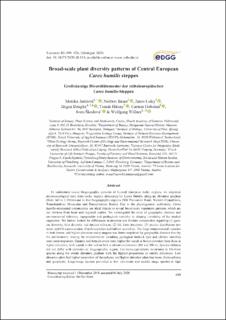Please use this identifier to cite or link to this item:
https://doi.org/10.21256/zhaw-20795Full metadata record
| DC Field | Value | Language |
|---|---|---|
| dc.contributor.author | Janisova, Monika | - |
| dc.contributor.author | Bauer, Norbert | - |
| dc.contributor.author | Csiky, János | - |
| dc.contributor.author | Dengler, Jürgen | - |
| dc.contributor.author | Hlásny, Tomás | - |
| dc.contributor.author | Hobohm, Carsten | - |
| dc.contributor.author | Skodová, Iveta | - |
| dc.contributor.author | Willner, Thomas | - |
| dc.date.accessioned | 2020-11-12T13:15:09Z | - |
| dc.date.available | 2020-11-12T13:15:09Z | - |
| dc.date.issued | 2020-11 | - |
| dc.identifier.issn | 0722-494X | de_CH |
| dc.identifier.issn | 0373-7632 | de_CH |
| dc.identifier.uri | https://digitalcollection.zhaw.ch/handle/11475/20795 | - |
| dc.description.abstract | To understand recent biogeographic patterns of Central European rocky steppes, we inspected phytosociological data from rocky steppes dominated by Carex humilis along an elevation gradient (from 140 to 1,350 m) and in four biogeographic regions (NW Pannonian Basin, Western Carpathians, Transdanubian Mountains and Transylvanian Basin). Due to the physiognomic uniformity, Carex humilis-dominated communities are ideal objects to reveal broad-scale vegetation patterns, which are not obvious from local and regional studies. We investigated the roles of geographic distance and environmental (climatic, topographic and geological) variables in shaping variability of the studied vegetation. We further looked for differences in structure and floristic composition regarding (1) gam-ma diversity, beta diversity and species richness; (2) life form spectrum; (3) species distribution patterns; and (4) representation of archaeophytes and habitat specialists. The large compositional variation in both lower- and higher-elevation rocky steppes was better explained by geographic distance than by the environment. Among the environmental variables, geological bedrock type and climate variables were most important. Gamma and beta diversity were higher for stands at lower elevation than those at higher elevation, with a peak in the colline belt at elevations between 300 and 500 m. Species richness did not differ with elevation or biogeographic region. The hemicryptophytes dominated in life-form spectra along the whole elevation gradient with the highest proportions at middle elevations. Low elevation plots had higher proportion of therophytes and higher elevation plots had more chamaephytes and geophytes. Large-range species prevailed at low elevations and middle range species at high elevations. Also the narrow-range species increased with elevation and among the regions were best represented in the W-Carpathians. Species with a European distribution prevailed in most plots and their proportion increased with elevation. The proportion of steppe species decreased with elevation and was highest in the Transylvanian plots. The W-Carpathian plots had the highest proportions of alpine species, which were present along the whole elevation gradient with a significantly increasing trend towards the high elevation. The archaeophytes were represented only at low and middle elevations with a decreasing trend, and had highest proportions in the Transylvanian plots. Mean niche breadth had unimodal distribution along the elevation gradient with the highest values at 600 m a.s.l. Proportions of both specialist and generalist species increased with elevation. Despite the mentioned differences, rocky steppes from various elevation belts and biogeographic regions shared a set of species with similar ecology and distribution. We conclude that a detailed analysis of biogeographic patterns based on phytosociological data can provide a valuable insight into the structure of a particular vegetation type. | de_CH |
| dc.language.iso | en | de_CH |
| dc.publisher | Floristisch-Soziologische Arbeitsgemeinschaft | de_CH |
| dc.relation.ispartof | Tuexenia | de_CH |
| dc.rights | Licence according to publishing contract | de_CH |
| dc.subject.ddc | 577: Ökologie | de_CH |
| dc.subject.ddc | 580: Pflanzen (Botanik) | de_CH |
| dc.title | Broad-scale diversity patterns of Central European Carex humilis steppes | de_CH |
| dc.type | Beitrag in wissenschaftlicher Zeitschrift | de_CH |
| dcterms.type | Text | de_CH |
| zhaw.departement | Life Sciences und Facility Management | de_CH |
| zhaw.organisationalunit | Institut für Umwelt und Natürliche Ressourcen (IUNR) | de_CH |
| dc.identifier.doi | 10.14471/2020.40.018 | de_CH |
| dc.identifier.doi | 10.21256/zhaw-20795 | - |
| zhaw.funding.eu | No | de_CH |
| zhaw.originated.zhaw | Yes | de_CH |
| zhaw.pages.end | 526 | de_CH |
| zhaw.pages.start | 499 | de_CH |
| zhaw.publication.status | publishedVersion | de_CH |
| zhaw.volume | 40 | de_CH |
| zhaw.publication.review | Peer review (Publikation) | de_CH |
| zhaw.webfeed | Vegetationsökologie | de_CH |
| zhaw.author.additional | No | de_CH |
| zhaw.display.portrait | Yes | de_CH |
| Appears in collections: | Publikationen Life Sciences und Facility Management | |
Files in This Item:
| File | Description | Size | Format | |
|---|---|---|---|---|
| 2020_Janisova_etal_Broad-scale-plant-diversity-patterns_Tuexenia.pdf | 12 MB | Adobe PDF |  View/Open |
Show simple item record
Janisova, M., Bauer, N., Csiky, J., Dengler, J., Hlásny, T., Hobohm, C., Skodová, I., & Willner, T. (2020). Broad-scale diversity patterns of Central European Carex humilis steppes. Tuexenia, 40, 499–526. https://doi.org/10.14471/2020.40.018
Janisova, M. et al. (2020) ‘Broad-scale diversity patterns of Central European Carex humilis steppes’, Tuexenia, 40, pp. 499–526. Available at: https://doi.org/10.14471/2020.40.018.
M. Janisova et al., “Broad-scale diversity patterns of Central European Carex humilis steppes,” Tuexenia, vol. 40, pp. 499–526, Nov. 2020, doi: 10.14471/2020.40.018.
JANISOVA, Monika, Norbert BAUER, János CSIKY, Jürgen DENGLER, Tomás HLÁSNY, Carsten HOBOHM, Iveta SKODOVÁ und Thomas WILLNER, 2020. Broad-scale diversity patterns of Central European Carex humilis steppes. Tuexenia. November 2020. Bd. 40, S. 499–526. DOI 10.14471/2020.40.018
Janisova, Monika, Norbert Bauer, János Csiky, Jürgen Dengler, Tomás Hlásny, Carsten Hobohm, Iveta Skodová, and Thomas Willner. 2020. “Broad-Scale Diversity Patterns of Central European Carex Humilis Steppes.” Tuexenia 40 (November): 499–526. https://doi.org/10.14471/2020.40.018.
Janisova, Monika, et al. “Broad-Scale Diversity Patterns of Central European Carex Humilis Steppes.” Tuexenia, vol. 40, Nov. 2020, pp. 499–526, https://doi.org/10.14471/2020.40.018.
Items in DSpace are protected by copyright, with all rights reserved, unless otherwise indicated.